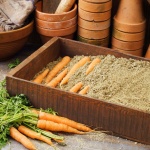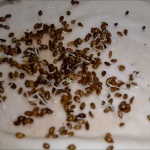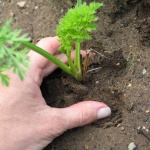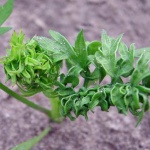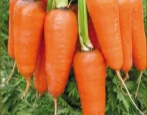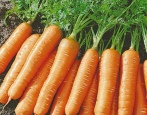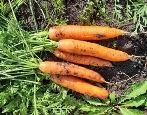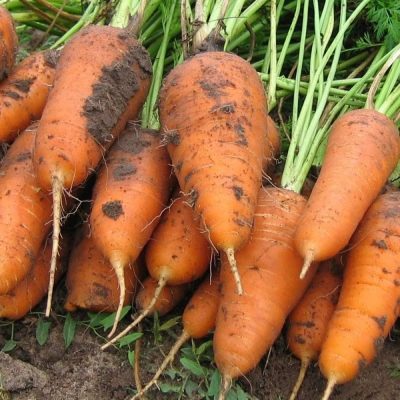
- Authors: Sakata
- Year of approval: 2007
- Appointment: for fresh consumption, for bundled products
- Leaf rosette shape: semi-spreading
- Leaves: long, light green, medium to coarsely dissected
- Weight, g: 90-160
- The form : conical with blunt tip
- Taste qualities: good ones
- Composition : dry matter 10.4-14.8%, total sugar 6.7-10.0%, carotene up to 20.4 mg per 100 g of raw matter
- Ripening terms: early
Carrots are a healthy and tasty vegetable that every gardener grows on his site. The main thing is to choose an optimally productive and unpretentious variety that quickly adapts to climatic conditions. For the North Caucasus region, the early ripe carrot variety Kuroda Shantane will be an excellent option.
Breeding history
Kuroda Shantane carrots were bred by scientists of the famous agricultural company Sakata Vegetables Europe S. A. S. in 2004. The vegetable crop appeared in the register of approved for use in 2007. The vegetable is cultivated in the North Caucasus region. In addition, the growing area covered Ukraine and Moldova. Carrots are grown in garden beds, in the fields, and on farmlands.
Description of the variety
The early carrots of Kuroda Shantane are a plant with a powerful semi-spreading rosette. The carrot tops are characterized by elongated light green medium and coarsely dissected leaves, as well as moderate thickening. The outlet does not have a pronounced aroma. Kuroda belongs to the Shantane cultivar, hence the name of the variety. It is also worth noting the resistance of the vegetable crop to shooting.
Characteristics of the appearance of the plant and root crops
Kuroda Shantane is a large-fruited variety, suitable for growing in a bunch. Carrots grows aligned, neat. A ripe root vegetable gains weight 90–160 g. The vegetable is short: 18–20 in length, 3–5 cm in diameter.
The shape of the root crop is conical with a rounded tip. Ripe carrots have a standard color: light orange. The surface of the vegetable is smooth, slightly shiny, with numerous, but shallow lenticels.
The dug carrots can be transported over long distances without significant losses. The vegetable is stored for a long time, the main thing is to create the right conditions: the room should be dry, cool (+ 2 ... + 4 °), dark.
Purpose and taste of tubers
The taste of carrots is excellent. The orange pulp of the root vegetable is dense, fleshy, slightly tender, juicy, without fiber. The core of the vegetable is small, completely indistinguishable in color from the pulp. The taste is dominated by summer sweetness and pleasant sugariness, complemented by a characteristic carrot aroma. A feature of the variety is the increased content of carotene, vitamins and sugar in carrot pulp.
Vegetables are widely used in cooking: they are added to hot and cold dishes, pickled, used for conservation, and frozen. The variety is ideal for winter storage.
Maturation
Kuroda is an early maturing variety. From germination to ripening of root crops, it takes 90-100 days. The seedlings of the culture are friendly. Carrots spice up pretty quickly. You can harvest at the end of July. The fruiting period is July - August - September.
Yield
The variety is declared as high-yielding, if you follow basic agricultural techniques. On average, 230-420 centners of succulent root crops can be harvested from 1 hectare. Up to 4 kg of carrots are harvested from 1 m 2 of a garden bed.
Growing and caring
Carrots are cultivated by the sowing method. The seeds are pre-treated with an antifungal drug. In the prepared area, grooves are prepared and the seeds are buried by 1 cm, no more. The distance between the rows is 18–20 cm. Planting is carried out according to the 5X18 / 20 cm scheme.
Sowing seeds is carried out from the end of April to the beginning of May, when the soil and air warm up a little. It is noteworthy that this variety can be planted twice - the second sowing is carried out at the end of July.
Agricultural engineering consists of basic procedures: regular watering, weeding and loosening of the soil, fertilizing twice during the growing season, mandatory thinning while maintaining a distance of up to 2-4 cm between plants, prevention of viruses and pest infestations.
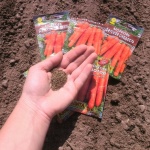
Carrots are one of the most unpretentious crops in terms of growing conditions; they can endure a short drought and a short cold snap. However, to get tasty and large root crops, you should adhere to the basic rules for planting carrots.


Soil requirements
Vegetable culture develops and bears fruit well, growing in comfortable conditions: in good soil. The soil for carrots should be fluffy, cleaned, well permeable to moisture and air, as well as nutritious, saturated with mineral fertilizers. It is important that the acidity is neutral or reduced.
Required climatic conditions
The culture has increased stress resistance. The vegetable is heat-resistant, able to withstand adverse weather conditions and a short drought. A bright, sunny place on the site is chosen for planting. Stable and moderate moisture is needed, as well as protection from strong winds.
Disease and pest resistance
The variety has good immunity, providing resistance to many diseases. If agrotechnical recommendations are violated, the plant may be exposed to diseases such as alternaria (brown spot), rot. Sometimes the culture is attacked by carrot flies and flies. An insecticide treatment is a reliable way to control pests.

Carrots grow in almost any garden. There is an opinion that this culture is very resistant to all kinds of diseases and pests, but this is not the case. Without proper care, carrots become susceptible to all kinds of infections and are affected by harmful insects.

